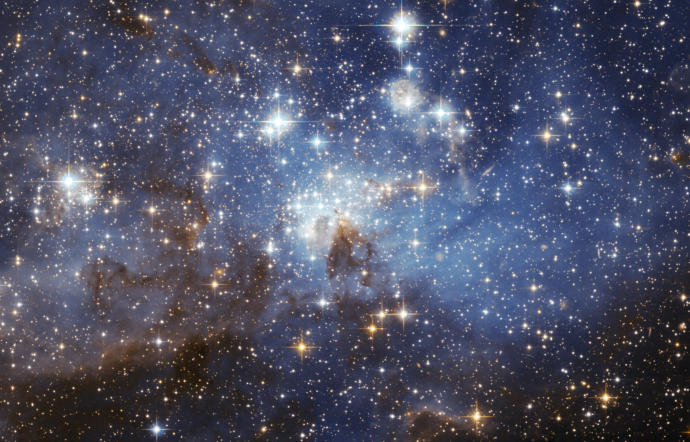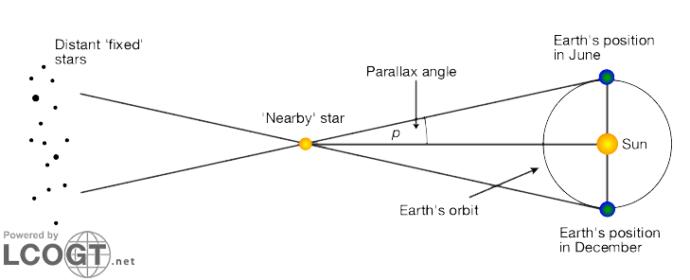Hey troops! So this shall be the first of my weekly (or whenever I have the time), science related MyTakes! Woo, I hope you are excited, 'cause I certainly am! The future of this series is looking bright, because we are going to be looking at the basics of stars!
What are Stars?

They are shimmering, sparkling and splendid but really stars are self-gravitating spheres of gas and plasma with some internal energy source. Most stars glow by emitting photons as part of the nuclear fusion processes that go on inside their cores, this is usually the fusion of Hydrogen into Helium. By understanding the stars, we can understand so much of what goes on in our universe, and in the night sky!
Distances to the Stars:

For nearby stars, we can use parallax to determine how far away they are. If the diagram above seems a bit confusing, don't worry! All will be explained soon.
As the Earth orbits around the Sun, the point of view of an observer on the surface changes, and thus the star appears to move in the sky. You can test this effect out for yourself, just put your finger at arms length in-front of you and open one eye at a time while focusing on something in the background. Your finger will jump as you change the eye you are looking at it with. By measuring the angle at which the star appears to change, you can use simple geometry to calculate the distance to the star! Now we can really get rolling! Fun fact: The nearest star to Earth is Proxima Centauri, which is 1.3 parsecs away ( a parsec is the distance where the object's position changes by 1/360 degrees), or 4.6 light years. That means it would take light, going at the fastest possible speed achievable according to Relativity, almost half a decade to get there. God, I feel lonely.
The Main Sequence:

When observing stars, we can start to plot graphs representing their certain characteristics because that stuff is interesting to us Astronomers, and also because we have no life. For instance, when we plot a graph of luminosity (how much energy a star emits) vs temperature, or luminosity vs density or stellar colour (the luminosity of a certain wavelength of light) vs absolute magnitude (basically a measure of the stars brightness), we see an interesting pattern emerge. We see the same line, going down from left to right, in pretty much every cluster of stars we have seen. We call this line the "Main Sequence" and it's where most stars can be found. It represents a pretty stable state, so stars like to hang out there for most of their lives.
At the end of their lives, the stars move off the main sequence and form into red giants and supergiant stars. The high mass stars go our with a bang, and eventually end up as neutron stars (super dense stars made up entirely of neutrons) or even black holes. The lighter mass stars, and our sun in roughly 5 billion years, will blow away their outer layers and become white dwarfs. There are some stars that never make it onto the main sequence, like brown dwarfs. They are cursed to live their lives in a dull, dark, depressing state of existence where they can never become real stars because they are too small to start nuclear fusion. Poor wee souls.
Thanks for reading!
That's it for today folks. I hope you enjoyed this little nerdy rant, and learned a lot from it too. If you have any questions, or suggestions for next time, please don't hesitate to comment.
Cya next time!
 Holidays
Holidays  Girl's Behavior
Girl's Behavior  Guy's Behavior
Guy's Behavior  Flirting
Flirting  Dating
Dating  Relationships
Relationships  Fashion & Beauty
Fashion & Beauty  Health & Fitness
Health & Fitness  Marriage & Weddings
Marriage & Weddings  Shopping & Gifts
Shopping & Gifts  Technology & Internet
Technology & Internet  Break Up & Divorce
Break Up & Divorce  Education & Career
Education & Career  Entertainment & Arts
Entertainment & Arts  Family & Friends
Family & Friends  Food & Beverage
Food & Beverage  Hobbies & Leisure
Hobbies & Leisure  Other
Other  Religion & Spirituality
Religion & Spirituality  Society & Politics
Society & Politics  Sports
Sports  Travel
Travel  Trending & News
Trending & News
Most Helpful Opinions